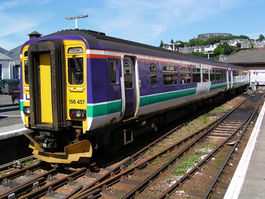Oban railway station
| Oban | |
|---|---|
| Scottish Gaelic: An t-Oban | |
 | |
| Location | |
| Place | Oban |
| Local authority | Argyll and Bute |
| Coordinates | 56°24′44″N 5°28′30″W / 56.4121°N 5.4749°WCoordinates: 56°24′44″N 5°28′30″W / 56.4121°N 5.4749°W |
| Grid reference | NM857298 |
| Operations | |
| Station code | OBN |
| Managed by | First ScotRail |
| Number of platforms | 2 |
|
Live arrivals/departures and station information from National Rail Enquiries | |
| Annual rail passenger usage* | |
| 2004/05 | 0.114 million |
| 2005/06 |
|
| 2006/07 |
|
| 2007/08 |
|
| 2008/09 |
|
| 2009/10 |
|
| 2010/11 |
|
| History | |
| Original company | Callander and Oban Railway |
| Pre-grouping | Callander and Oban Railway operated by Caledonian Railway |
| 1 July 1880 | Opened |
| National Rail – UK railway stations | |
| A B C D E F G H I J K L M N O P Q R S T U V W X Y Z | |
| * Annual estimated passenger usage based on sales of tickets in stated financial year(s) which end or originate at Oban from Office of Rail Regulation statistics. Methodology may vary year on year. | |
|
| |
Oban railway station is a railway station serving Oban in Scotland. It is the terminus of one branch of the highly scenic West Highland Line 101.3 miles (163 km) north of Glasgow Queen Street. It was originally the terminus of the Callander and Oban Railway. Services are operated by First ScotRail.
History

Oban station opened on 1 July 1880. A ticket platform (long since disused but still in situ) was located on the west side of the single line, about half a mile to the south. Just south of there, a short branch line diverged to the east, towards a goods yard and engine shed.
Two additional platforms were constructed on the west side of the station in 1904, following the opening of the branch from Connel Ferry to Ballachulish.
Following closure of the goods yard and engine shed, a rail-connected oil storage depot occupied part of the site for a number of years, although this has itself since closed.
Since 1982, only the 1904-built platforms remain in use (still numbered as Platforms 3 and 4). The present small station building was officially opened on 3 January 1986, the occasion being marked by the naming of two Class 37 locomotives. Despite it being a listed building, the original station building was subsequently demolished.
Signalling
Since its opening on 1 July 1880, the single line between Dalmally and Oban was worked by the electric token system, this being the first ever application of that system in everyday service.
Oban originally had two signal boxes, namely Oban Station signal box (the larger of the two), and Oban Goods Junction signal box. The latter was situated about a quarter mile further south, where the line to the goods yard and engine shed diverged from the single line. The original signal boxes contained 21 and 5 levers, respectively. The single line between the two boxes was doubled in 1881.
In connection with the station's enlargement, Oban Station Signal Box was replaced (on the opposite side of the line and slightly nearer the station) in 1904. The new box contained a frame of 64 levers, subsequently shortened to 48. Oban Goods Junction S.B. was replaced in 1929.
Oban Goods Junction S.B. closed on 4 May 1969. Oban Station S.B. closed on 5 December 1982, when a 'no signalman' system of electric token working was introduced on the section from Taynuilt signal box. The last remaining semaphore signals were removed at that time, including the signal gantry.
The Radio Electronic Token Block system was introduced in 1988 and the Train Protection & Warning System was installed in 2003.
Services

Summer 2007
In Summer 2007, there were four trains a day to and from Glasgow Queen Street along the West Highland Line.
Winter 2007/08
During winter 2007/08, there were three trains a day to and from Glasgow Queen Street along the West Highland Line.
Summer 2011
On Mondays to Saturdays there were three trains to/from Glasgow Queen Street with a fourth train on Saturdays. On Sundays there were three trains to/from Glasgow Queen Street and an extra service to/from Edinburgh Waverley.
Winter 2011/12
On Mondays to Saturdays, there are three trains to/from Glasgow Queen Street. On Sundays there is just one train to/from Glasgow Queen Street.
| Preceding station | |
Following station | ||
|---|---|---|---|---|
| Connel Ferry | First ScotRail West Highland Line |
Terminus | ||
| Historical railways | ||||
| Connel Ferry Line and station open |
Callander and Oban Railway Caledonian Railway |
Terminus | ||
Sources
| Wikimedia Commons has media related to Oban railway station. |
- Butt, R. V. J. (1995). The Directory of Railway Stations: details every public and private passenger station, halt, platform and stopping place, past and present (1st ed.). Sparkford: Patrick Stephens Ltd. ISBN 1-8526-0508-1. OCLC 60251199.
- Fryer, Charles (1989). The Callander and Oban Railway. Oxford: Oakwood Press. ISBN 0-8536-1377-X. OCLC 21870958.
- Jowett, Alan (March 1989). Jowett's Railway Atlas of Great Britain and Ireland: From Pre-Grouping to the Present Day (1st ed.). Sparkford: Patrick Stephens Ltd. ISBN 1-8526-0086-1. OCLC 22311137.